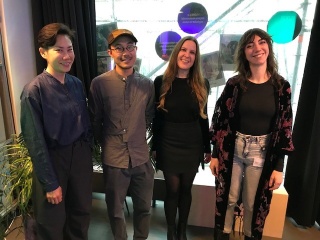Design, creativity and innovation for societal impact
03-03-2025

At the AUAS Food for Thought session on Tuesday 25 February, four associate professors from the FDMCI Centre for Applied Research shared surprising insights. Each of them looked in a unique way at human-centred design and how we can use creativity and innovation to make the world a little more beautiful. Two of them, Simone de Droog and Bin Yu, are associated with the Digital Life research group.
Four central questions were raised: how can we create designs that contribute to a better world (Jaz Choi from the research group Civic Interaction Design)? How can stories bring us closer to each other and to nature (Elise Talgorn from the research group Creative Media for Social Change)? What can social robots mean for children (Simone de Droog)? And how do a few heartbeats lead to a significant impact on societal well-being (Bin Yu)?
We will briefly highlight the contributions of Simone and Bin here.
Robots for Play, Connection, Comfort and Growth
Children today face numerous challenges that limit their opportunities to thrive – ranging from staff shortages in education and healthcare to increasing urbanization, safety concerns, and declining face-to-face interactions. Could robots offer a solution?
By bridging the gap between children’s digital and physical worlds, robots tap into their natural curiosity and create meaningful, human-like interactions through storytelling and play. In her research, Simone explores how emerging technologies can support children and address societal challenges.
During her talk, Simone showcased robots like the Dream Robot, HARRy Robot, and Playbot, demonstrating how they assist teachers and healthcare professionals, inspire creativity, and promote social connection, fostering healthier, happier, and more fulfilling childhood experiences.
Simone's motivation
Many challenges in society require sustainable solutions, so interventions must be able to grow with children's interests, preferences and needs, which, as they grow older, change due to cognitive and socio-emotional developments, among other things.
So what we need are design principles for developing more adaptive (and therefore sustainable) interventions. Moreover, the increasing role of technology in children's lives raises questions about children's social and mental development, health, safety and privacy.
Turning Small Data into Big Impact
Heart rate is one of the most frequently measured data in our daily lives, collected by various wearable devices for health and fitness. However, these data often remain confined to apps with limited impact beyond personal use.
How can a small piece of personal data, like heart rate, be used in a broader context to create a greater positive social impact? Bin Yu offered his answer: by designing new meanings and experiences around data. Through Heart Bloom, he demonstrated how data can drive a series of innovative design practices.
During this Food for Thought Bin Yu showcased his design journey, which starts with three minutes of heart rate data and culminates in a charitable fundraising platform that supports children with heart diseases.
Bin's motivation
AI has become a powerful tool in computer-aided diagnosis. Yet it remains challenging to apply AI solutions widely in healthcare. This is often due to overconfidence or lack of confidence in AI, as well as poor integration with existing workflows.
Bin's research efforts to date have led to a number of crucial research questions that he continues to explore at Digital Life, such as:
• How can we integrate AI into current healthcare workflows in such a way that work can be done more efficiently and effectively? • How can we smartly divide the tasks of AI and doctors so that they can work better together? And how can we develop techniques that help users better understand what AI can and cannot do? • How does AI make decisions that will increase trust in AI and its successful application in healthcare?

